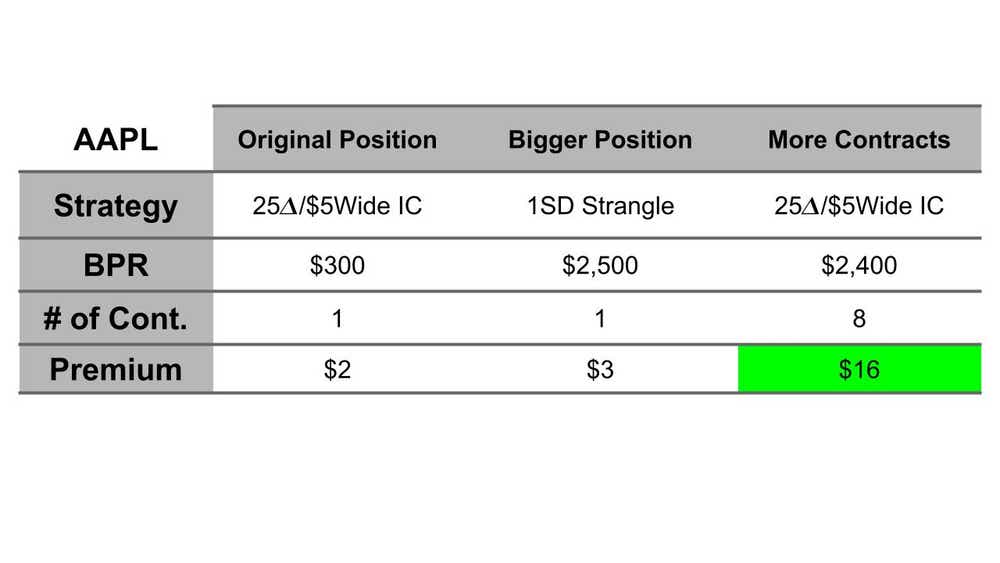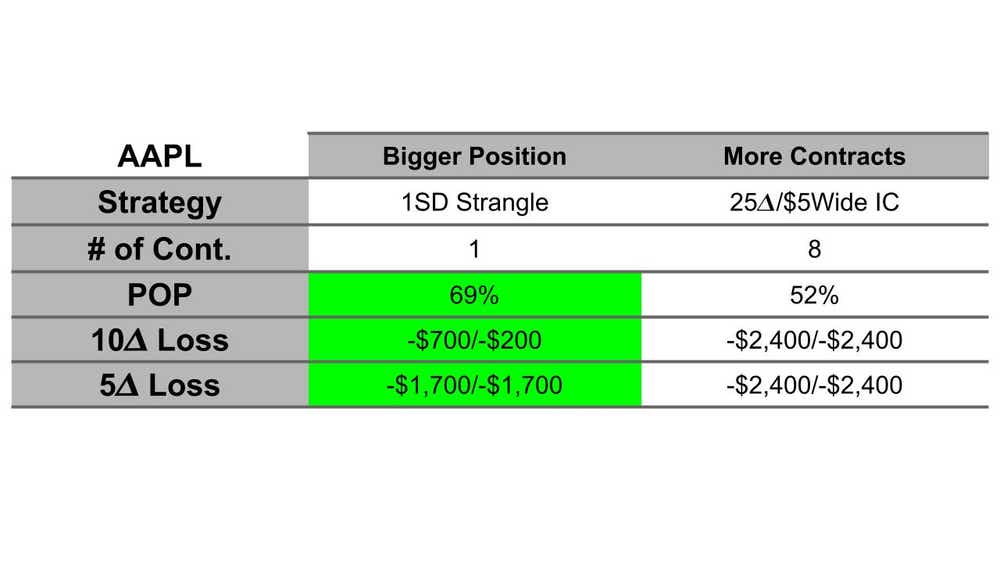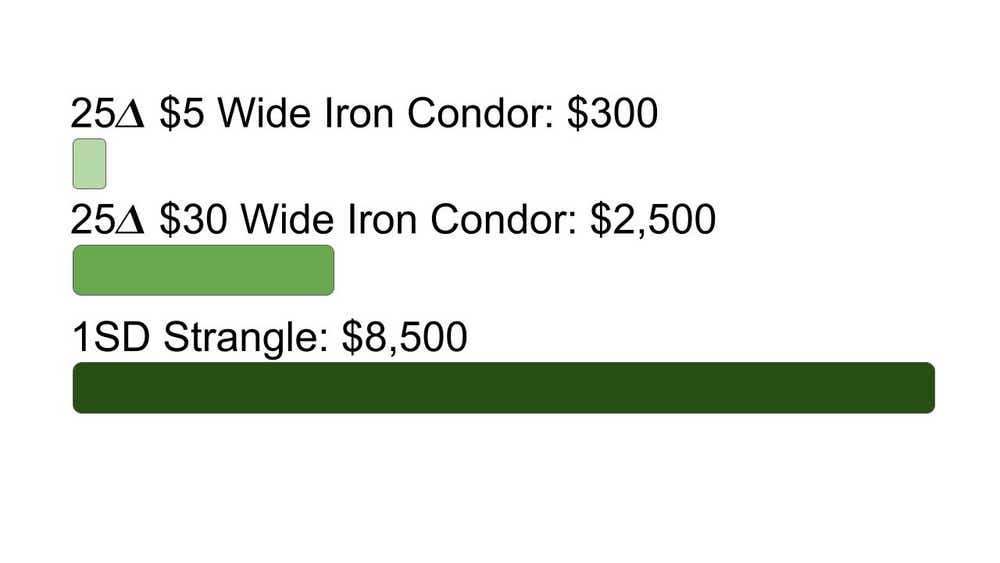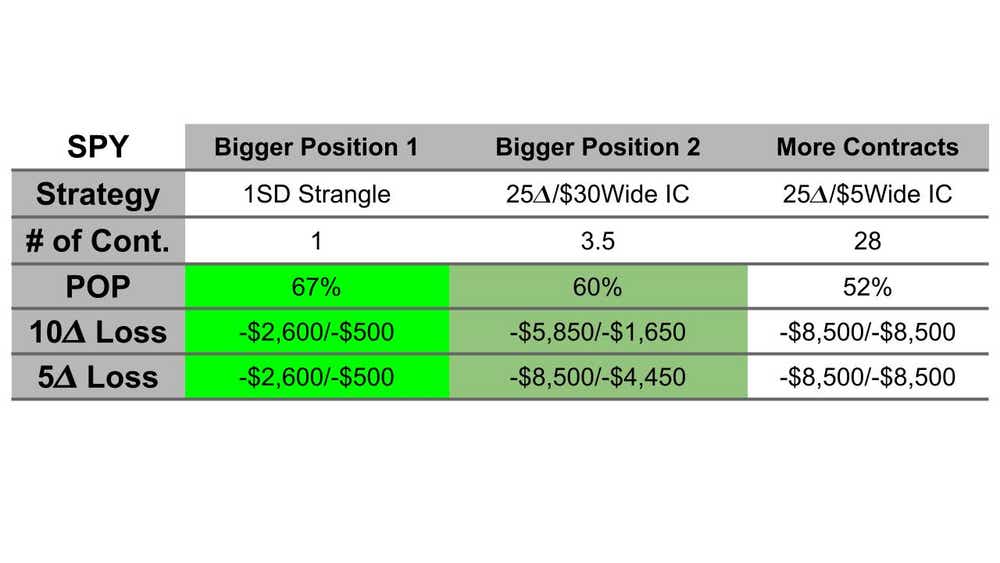Scaling Up in Small Accounts

Scaling Up in Small Accounts
By:Kai Zeng
Strategies to Increase Capital Allocation
- Here's how to safely scale up in small account.
- You can also limit exposure of small accounts.
- But understand the probability of risk vs. max risk.
The journey of scaling up trading capital presents numerous challenges, especially for small account traders with limited funds. If our account size grows or we bring in more capital, what are the best ways to increase our capital allocation?
There are two primary approaches when it comes to increasing trading size. One could increase the individual position's risk/buying power requirement (such as by using a strangle instead of an iron condor), and by increasing the number of contracts (such as by doubling or tripling the original iron condor positions).
How this could work
Let's take two examples: Apple (AAPL) and SPDR S&P 500 ETF Trust (SPY). For AAPL, the buying power required and the probability of profit for trading a small iron condor vs. a strangle differ significantly.

While the iron condor may offer higher premiums with the same amount of capital allocated, there is a higher chance of reaching maximum loss due to its low success rate. Small accounts are highly vulnerable to large losses, meaning that a single major loss could totally deplete the funds available to continue trading.

On the other hand, index-linked exchange-traded funds (ETFs) tend to have lower implied volatility than equities. That increases the buying power requirements significantly, making it difficult for small-account traders to afford. Thus, for SPY, we added a $30 wide iron condor in addition to the strangle, to help keep the buying power requirement lower. Additionally, ETFs tend to have a strong put skew which impacts the difference in loss potential between call and put options.

We found a similar pattern here in SPY. When it comes to increasing trade size, it's not a good idea to just add more contracts. A better approach is to widen the spread while keeping the number of contracts as low as possible to reduce the tail risk. This strikes a balance between premium and risk, thus reducing the risk of large losses which can be detrimental to small accounts.

Understand the risk
In conclusion, the journey of scaling up one's options trading is not without its hurdles. However, by considering risk and the probability of loss, traders can navigate this path successfully. Understanding the risk involved and making informed decisions is the key to overcoming these challenges. By striking a balance between premium and risk, traders can ensure their growth is not only profitable but also sustainable in the long run. Remember, the goal is not just to scale up but to do so in a manner that ensures long-term success.
Kai Zeng, director of the research team and head of Chinese content at tastylive, has a 20-year background in derivatives trading and market experience. He cohosts several live shows, including From Theory to Practice and Building Blocks. @kai_zeng1
For live daily programming, market news and commentary, visit tastylive or the YouTube channels tastylive (for options traders), and tastyliveTrending for stocks, futures, forex & macro.
Trade with a better broker, open a tastytrade account today. tastylive, Inc. and tastytrade, Inc. are separate but affiliated companies.
Options involve risk and are not suitable for all investors. Please read Characteristics and Risks of Standardized Options before deciding to invest in options.
tastylive content is created, produced, and provided solely by tastylive, Inc. (“tastylive”) and is for informational and educational purposes only. It is not, nor is it intended to be, trading or investment advice or a recommendation that any security, futures contract, digital asset, other product, transaction, or investment strategy is suitable for any person. Trading securities, futures products, and digital assets involve risk and may result in a loss greater than the original amount invested. tastylive, through its content, financial programming or otherwise, does not provide investment or financial advice or make investment recommendations. Investment information provided may not be appropriate for all investors and is provided without respect to individual investor financial sophistication, financial situation, investing time horizon or risk tolerance. tastylive is not in the business of transacting securities trades, nor does it direct client commodity accounts or give commodity trading advice tailored to any particular client’s situation or investment objectives. Supporting documentation for any claims (including claims made on behalf of options programs), comparisons, statistics, or other technical data, if applicable, will be supplied upon request. tastylive is not a licensed financial adviser, registered investment adviser, or a registered broker-dealer. Options, futures, and futures options are not suitable for all investors. Prior to trading securities, options, futures, or futures options, please read the applicable risk disclosures, including, but not limited to, the Characteristics and Risks of Standardized Options Disclosure and the Futures and Exchange-Traded Options Risk Disclosure found on tastytrade.com/disclosures.
tastytrade, Inc. ("tastytrade”) is a registered broker-dealer and member of FINRA, NFA, and SIPC. tastytrade was previously known as tastyworks, Inc. (“tastyworks”). tastytrade offers self-directed brokerage accounts to its customers. tastytrade does not give financial or trading advice, nor does it make investment recommendations. You alone are responsible for making your investment and trading decisions and for evaluating the merits and risks associated with the use of tastytrade’s systems, services or products. tastytrade is a wholly-owned subsidiary of tastylive, Inc.
tastytrade has entered into a Marketing Agreement with tastylive (“Marketing Agent”) whereby tastytrade pays compensation to Marketing Agent to recommend tastytrade’s brokerage services. The existence of this Marketing Agreement should not be deemed as an endorsement or recommendation of Marketing Agent by tastytrade. tastytrade and Marketing Agent are separate entities with their own products and services. tastylive is the parent company of tastytrade.
tastyfx, LLC (“tastyfx”) is a Commodity Futures Trading Commission (“CFTC”) registered Retail Foreign Exchange Dealer (RFED) and Introducing Broker (IB) and Forex Dealer Member (FDM) of the National Futures Association (“NFA”) (NFA ID 0509630). Leveraged trading in foreign currency or off-exchange products on margin carries significant risk and may not be suitable for all investors. We advise you to carefully consider whether trading is appropriate for you based on your personal circumstances as you may lose more than you invest.
tastycrypto is provided solely by tasty Software Solutions, LLC. tasty Software Solutions, LLC is a separate but affiliate company of tastylive, Inc. Neither tastylive nor any of its affiliates are responsible for the products or services provided by tasty Software Solutions, LLC. Cryptocurrency trading is not suitable for all investors due to the number of risks involved. The value of any cryptocurrency, including digital assets pegged to fiat currency, commodities, or any other asset, may go to zero.
© copyright 2013 - 2025 tastylive, Inc. All Rights Reserved. Applicable portions of the Terms of Use on tastylive.com apply. Reproduction, adaptation, distribution, public display, exhibition for profit, or storage in any electronic storage media in whole or in part is prohibited under penalty of law, provided that you may download tastylive’s podcasts as necessary to view for personal use. tastylive was previously known as tastytrade, Inc. tastylive is a trademark/servicemark owned by tastylive, Inc.